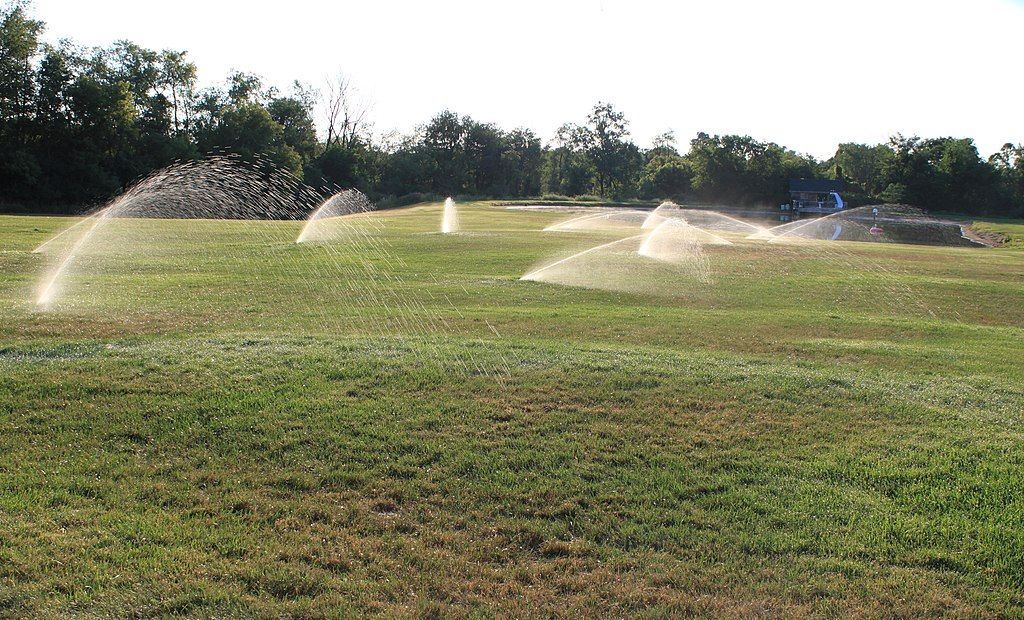
26 July 2016
If you think about it, a lot of us are farmers. We devote our small acreage to a crop that we fertilize, water and harvest. Then we throw away the harvest or grind it up to re-fertilize the crop. We never eat it and we don’t feed it to our animals.
Grass. In Pennsylvania we devote 2 million acres to lawns. Our next largest crop uses 1.6 million acres. (*See table below.)
The amazing dominance of the lawn is true everywhere in the continental the U.S. except in the Central West — Montana to Nevada to Kansas — where hay, corn and soybeans take up more space. Click here and scroll down for the map.
This isn’t really news. A 2005 study by Cristina Melisi used satellite data to show that lawns are the largest crop in America and the most irrigated by acreage. This is no surprise in Florida and the West where lawns have built-in irrigation systems, but do we irrigate in the Northeast? You bet! The sprinklers are running this month.
Some homeowners break the mold by making meadows or growing vegetables but they often have to explain it to their neighbors. The two-year-old Beacon-Bartlett meadow in Schenley Park has educational signs explaining “This is intentional.”
If I was a gardener I’d convert my tiny backyard lawn but I’m not even a participant. I am, at best, an observer using my Newcomb’s Guide to identify what comes up. I never water, weed or seed it. When it grows, it gets cut. It’s not growing right now.
(photo from Wikimedia Commons. Click on the image to see the original)
(*) UPDATED 22 June 2023: Thank you Mary Ann Pike for providing this link at USDA with which I populated this table with Pennsylvania crop statistics.
| Cultivation/ Crop | Acreage in PA |
| Lawns | 2.0 million |
| Hay and Haylage | 1.5 million |
| Corn | 1.2 million |
| Soybeans | 0.6 million |
| Wheat | 0.3 million |
This means that lawns are about 30% of Pennsylvania’s cultivated lands.
There are lots of versions of this, including one by Scott Shalaway, which was in his column (he modified another guy’s original) – but I can’t find it anymore.
Here’s a good one. God and St. Francis discuss lawns. . .
https://answers.yahoo.com/question/index?qid=20090602153945AA6TzMa
I wonder what the origin of the lawn is? I read somewhere that George Washington seems to have propagated the idea of having a clean lawn in the US, he wanted his yard, or perhaps the President’s residence, to have the look of the English lawns over the pond.
Steve, the lawn is relatively new because we had to wait until there was a less sheep-intensive and labor-intensive way to cut it. This New Yorker article by Elizabeth Kolbert explains it all: http://www.newyorker.com/magazine/2008/07/21/turf-war-2
Kate, I was wondering about your numbers for crops in PA. Here is a PA agricultural summary from the USDA giving statistics about various crop production in the state in 2015. Corn is listed as almost a million harvested acres for grain, half a million acres for soybeans, 20,000 acres for apples, etc. Even sweet corn, which would perhaps be the only corn used for food, is 9,300 acres. https://www.nass.usda.gov/Quick_Stats/Ag_Overview/stateOverview.php?state=pennsylvania
Mary Ann, thanks for the data. I got them from the map at the link. I wonder what basis the used. I’ll put a footnote and check on it.
Also, I would like to know how they estimate the acreage of “irrigated” lawns. I will admit, when we were kids, sometimes my dad watered the lawn because they had a type of grass on their property that turned brown very easily. But in the 30+ years that we’ve been homeowners, we’ve *never* watered our lawn (much to the irritation of our neighbors when we lived in Upper St. Clair, I’m sure). I’m pretty sure my brother and sister don’t water their lawns much, if any, either. I don’t think that, in Pennsylvania, unless you live in one of those upscale communities where they require your grass to look like a golf course, many people need to regularly water their lawns. I was horrified one time when a colleague of mine who worked in our Scottsdale AZ office sent me a photo where one side of the road was desert, and the other side contained a housing development with lush lawns and swimming pools. I cannot imagine how much water was being used needlessly in that development.
Mary Ann, the irrigation numbers are nationwide and include golf courses. Florida, California and the Southwest tip the scales. Cristina Milesi got interested in studying lawns because she came from Italy (where they don’t irrigate lawns) and ended up at Univ of Montana at Missoula where lawns have to be irrigated all summer to survive. heck out this link for more information: http://earthobservatory.nasa.gov/Features/Lawn/lawn.php